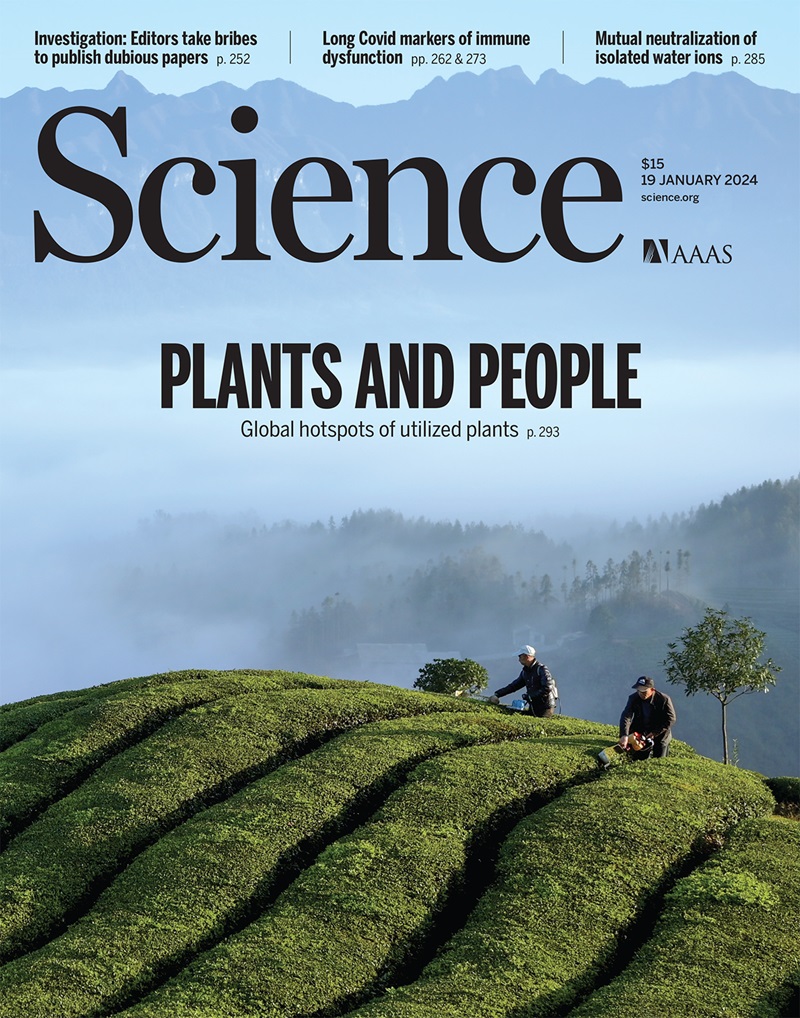Quadruple-band synglisis enables high thermoelectric efficiency in earth-abundant tin sulfide crystals
IF 45.8
1区 综合性期刊
Q1 MULTIDISCIPLINARY SCIENCES
引用次数: 0
Abstract
Thermoelectrics have been limited by the scarcity of their constituent elements, especially telluride. The earth-abundant, wide-bandgap (Eg ≈ 46 kBT) tin sulfide (SnS) has shown promising performance in its crystal form. We improved the thermoelectric efficiency in SnS crystals by promoting the convergence of energy and momentum of four valance bands, termed quadruple-band synglisis. We introduced more Sn vacancies to activate quadruple-band synglisis and facilitate carrier transport by inducing SnS2 in selenium (Se)–alloyed SnS, leading to a high dimensionless figure of merit (ZT) of ~1.0 at 300 kelvin and an average ZT of ~1.3 at 300 to 773 kelvin in p-type SnS crystals. We further obtained an experimental efficiency of ~6.5%, and our fabricated cooler demonstrated a maximum cooling temperature difference of ~48.4 kelvin at 353 kelvin. Our observations should draw interest to earth-abundant SnS crystals for applications of waste-heat recovery and thermoelectric cooling.
四波段合成使地球丰富的硫化锡晶体具有高热电效率
热电材料一直受到其组成元素(尤其是碲化物)稀缺的限制。地球上储量丰富的宽禁带(E g≈46 k B T)硫化锡(sn)在晶体形态上表现出了良好的性能。我们通过促进四个价带的能量和动量的收敛来提高SnS晶体的热电效率,称为四带合成。我们在硒(Se)合金的SnS中引入了更多的Sn空位来激活四能带合成,并通过诱导SnS 2来促进载流子的传输,导致p型SnS晶体在300开尔文时的无因次优值(ZT)高达1.0,在300 ~ 773开尔文时的平均ZT为1.3。我们进一步获得了~6.5%的实验效率,并且我们制造的冷却器在353开尔文时的最大冷却温差为~48.4开尔文。我们的观察结果应该引起人们对地球上丰富的SnS晶体在废热回收和热电冷却方面的应用的兴趣。
本文章由计算机程序翻译,如有差异,请以英文原文为准。
求助全文
约1分钟内获得全文
求助全文
来源期刊

Science
综合性期刊-综合性期刊
CiteScore
61.10
自引率
0.90%
发文量
0
审稿时长
2.1 months
期刊介绍:
Science is a leading outlet for scientific news, commentary, and cutting-edge research. Through its print and online incarnations, Science reaches an estimated worldwide readership of more than one million. Science’s authorship is global too, and its articles consistently rank among the world's most cited research.
Science serves as a forum for discussion of important issues related to the advancement of science by publishing material on which a consensus has been reached as well as including the presentation of minority or conflicting points of view. Accordingly, all articles published in Science—including editorials, news and comment, and book reviews—are signed and reflect the individual views of the authors and not official points of view adopted by AAAS or the institutions with which the authors are affiliated.
Science seeks to publish those papers that are most influential in their fields or across fields and that will significantly advance scientific understanding. Selected papers should present novel and broadly important data, syntheses, or concepts. They should merit recognition by the wider scientific community and general public provided by publication in Science, beyond that provided by specialty journals. Science welcomes submissions from all fields of science and from any source. The editors are committed to the prompt evaluation and publication of submitted papers while upholding high standards that support reproducibility of published research. Science is published weekly; selected papers are published online ahead of print.
 求助内容:
求助内容: 应助结果提醒方式:
应助结果提醒方式:


